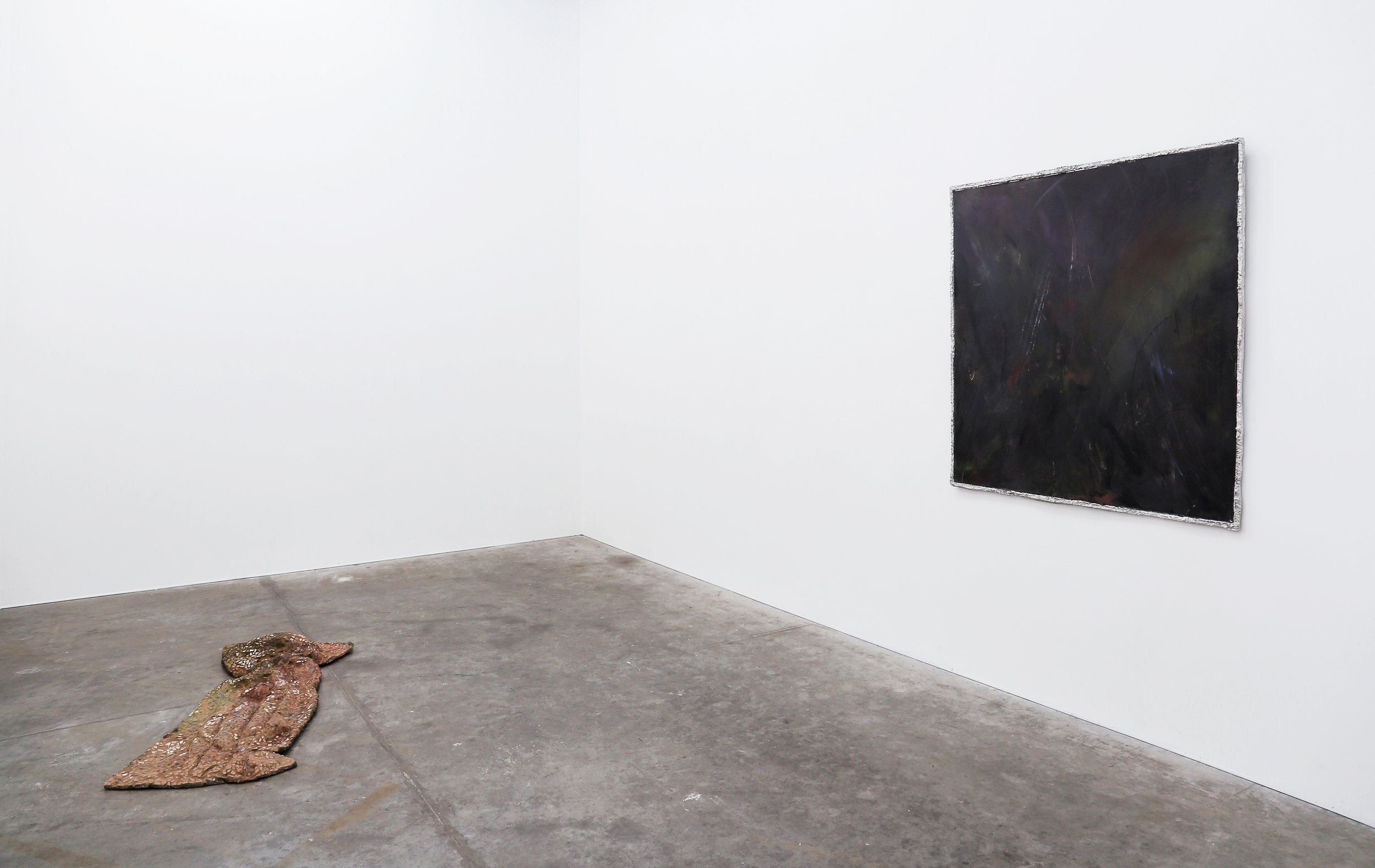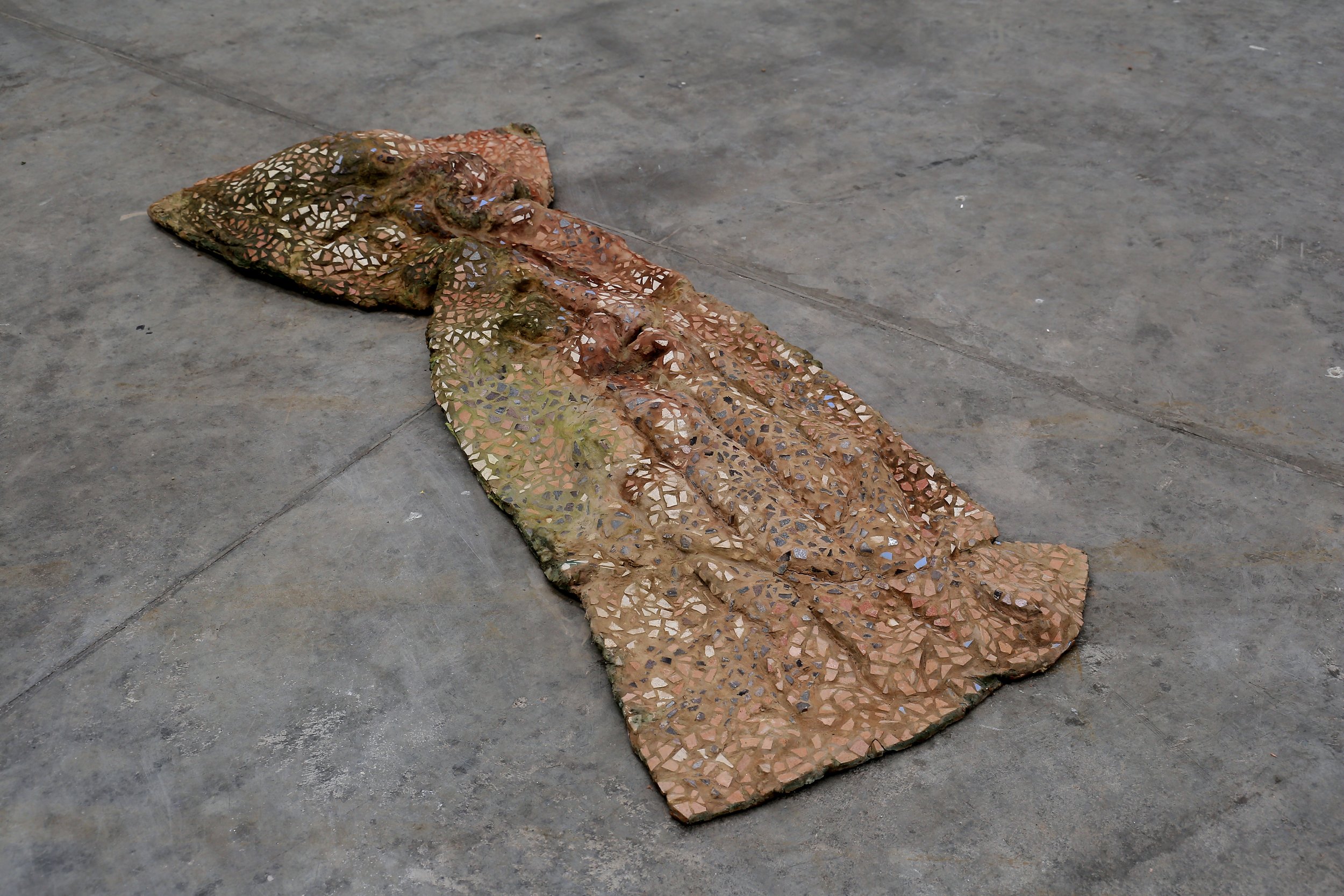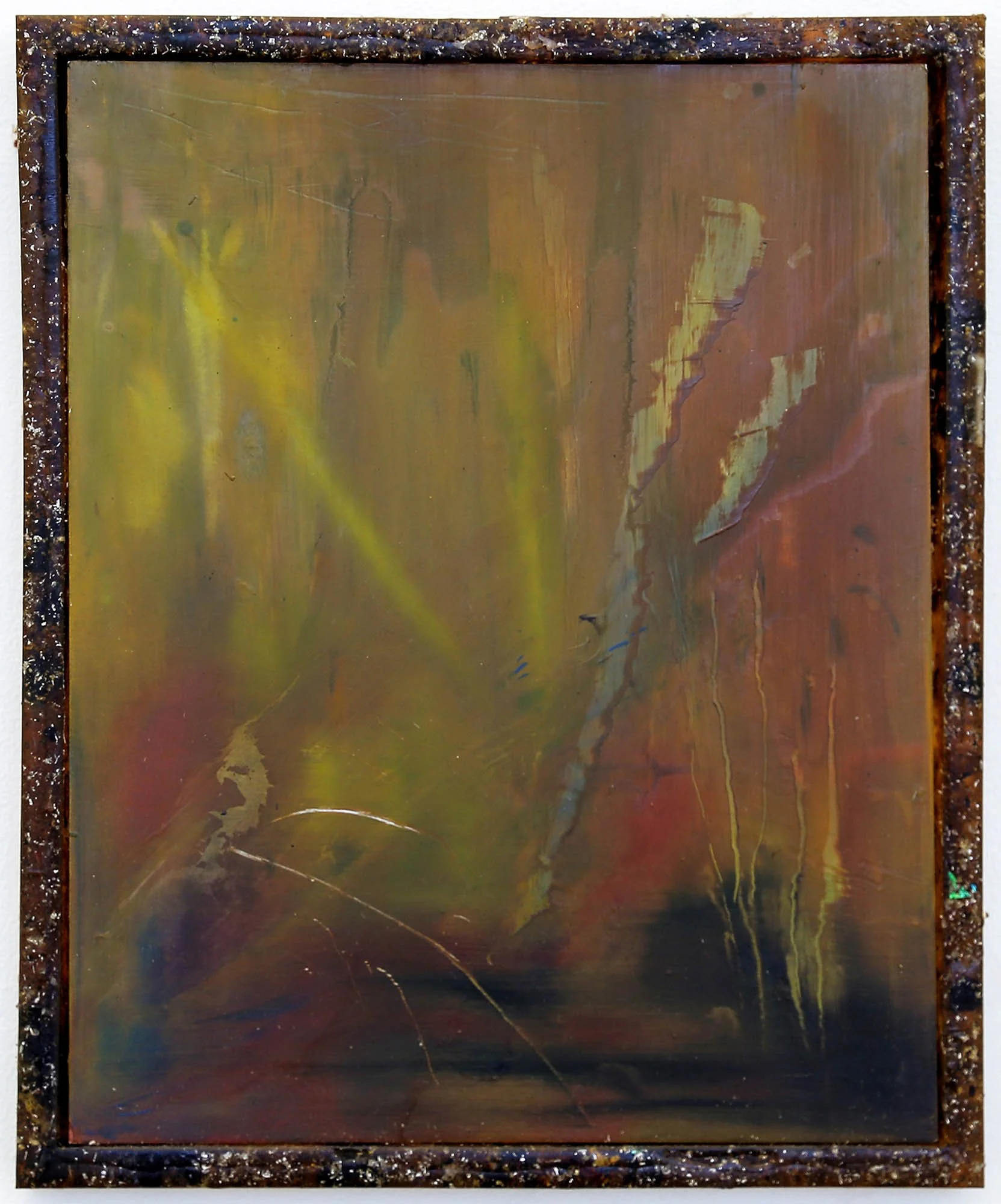Lilo, 2022. Found material, tiles, grout, plaster. 1500 x 600mm x 100mm.
Watery Grave, 2022. Oil on aluminium and cast pewter frame. 1260 x 1260mm.
Socket, 2022. Oil on aluminium, cast resin mixed media. 210 x 165mm.
Scanner, 2022. Oil on aluminium, cast resin mixed media. 280 x 225mm.
Wet Plate, 2022. Jonathan Smart Gallery, Christchurch.
ELIXIR LAKE,
Recently, I have been swimming laps again. At the bottom of the pool swills a layer of sediment from the poolside peripheral, leaves and dirt cast in by overhanging trees, debris of plastic, latex and cotton, filaments shedded from nylon swimming togs, an occasional flake of silver or bead lost to the rhythmic suctioning of the filter. I am another substance in this soup, an amalgamation of strands of hair, skin cells, saliva, chlorine, sunscreen. The poolscape is contained by a border of blue concrete aggregate, a modest imitation of the colour of the ocean. From bird’s eye, this balance between frame and water, solution and particle, is a parallel composition to Tyne Gordon’s painted works. Inversely: Gordon’s paintings are surfaces for swimming in.
The register that Gordon works in is of things cast off.
branch broken in high wind, accidental beam of light.
In a banal photograph that I made as a child, a phantom spray of water vaults through the image, as though a garden sprinkler had gone off just as the shutter clicked. There was no sprinkler though, only an accidental arc of light appearing somewhere between the backyard and the roll of film. It was this imperfect photo that I remembered when I first saw Tyne Gordon’s paintings for Wet Plate. The paintings are scored with the same curving light form, but unlike my image, Gordon’s forms are really derived from the watery trajectory of a garden hose.
I can not think about Gordon’s work without thinking also of photography, as a practice where light behaves as found object, detritus of other circumstances which have been rendered invisible. Gordon’s too, is an alchemical process of a reaction occurring on a metal plate. Her works are produced through layered application of oils on a sheet of copper or aluminium. In his essay on photography, Walter Benjamin writes of Daguerre’s iodised silver plates, a picture so delicate fixed on them that the beholder was required to tilt the object back and forward to make out its grey contours.1 This is the same motion that took place in the studio, Gordon angling the work to illuminate the thicket of matte and lustre forms. The earliest plates had such low photosensitivity that they needed to be exposed to the open air for lengthy periods of time.2 To make an image, environment and chemical must coalesce and crystallise.
“Everything on earth is food: earth, water, fire, air, plant, animal, light,” writes Ross Simonini in his essay “Warm Home Energy.”3 When Gordon texts me recipes for the resin frames that shelter the metal panes, I recall a favourite game of assembling imaginary meals from the wastes of the playing field. It was always a negotiation of magic, beauty, material and illusion; the dish should look like a perfect cookie, even, or especially, if it was made of gladwrap and hair bobble fossilised in a gravelly mound. The interplay between industrial material and organic matter is a recurring idea for Gordon. Lichen, silver leaf, tarseal and resin comprise the frame of Scanner, a mixture poured into a silicon mould, and turned out when set. In another, strands of iridescent tinsel are suspended in a cloudy swamp. There is a visual rhyme here, with the texture of grass trampled into mud, the blades pushing up through the sludge. The fibrous grass mixed with the smooth texture of wet soil resembles fibreglass, and so Gordon’s frame becomes both of these too. I play with the words, substituting glass with grass. Fibregrass, a slick of sod masquerading as synthetic textile.
A sheet of pewter-cast bark chips are strung in the gallery space, Spray. There is a difference in the composition of old and new pewter. The newer kind is an alloy of tin, copper and antimony, a metallic concoction that has replaced the old composite of tin and lead. There is something darker and duller about pewter than other metals. Maybe it is that its pocked texture holds onto nocturne shadows better, but it might also be a characteristic of the metals that it is comprised of. Pewter has a low melting point, around 250 degrees celsius, the temperature that Gordon must reach to turn a collection of abandoned commemorative tumblers into a liquid from which to forge. Not without peril, transforming the pewter exudes poisonous fumes. Of lead, so of poison, an equilibrium danger between toxin and natural, above a nighttime potion.
When Spray wavers, the light snags like running water river bed, so I guess they are earth and water at once. The sound of them caught by wind might chime, bell-like magical or sacred Or like the rounded sound of water falling from sky and dam. By passing from the entrance of the gallery to the rear spaces, we are the shower passing through.
We did experience several days of heavy rain at the beginning of February, strange for the time of year. The ground had already been baked hard by the lack of rainfall prior, the rocks smooth and dusty and crusted together by clay soil. With the deluge, ribbons of water excavate the ground, turning the clay into a thick umber slurry. I imagine, over eons, the rivulets eroding the rock deep enough to exhume an abandoned swimming pool, the tilework from the pool crusting with minerals and moss onto lilos and buoys deflated by time and swollen in the substrate and lichen. These are Gordon’s inflatable forms, ground as painterly grout for strange tiles and worked slumps of dark green. To uncover these objects is to find relics of a ritual forgotten and unknown.
The currency of Gordon’s work is the mystical and ritual, as though we turned up when the party was over, left to sift through its accessories. In a poem in The Goose Bath, Janet Frame writes:
“I take into my arms more than I can bear to hold / I am toppled by the world / a creation of ladders, pianos, stairs cut into rocks.”4
There is an ecstasy to things that go up, in the mantra of their repetition. Gordon’s sculptures follow similar logics, a miracle embedded between all these found things that fit together anyway. Moth and Monotreme are assemblages of abstruse objects that are illegible on their own. As compositions though: cake of garden reel and Christmas tree, concentric towers where meaning is generated through combining and believing.
This is an inventory of the world and Wet Plate is wading through its architecture, pulling a glittering horizon of parts toward us.
“What is aura, in fact? A gossamer fabric woven of space and time: a unique manifestation of a remoteness, however close at hand...until the moment or the hour shares in the manifestation— that is called breathing in the aura... well, ‘bringing things closer.’”5
Jane Wallace
1 Walter Benjamin, “A Brief History of Photography,” in One-way Street and Other Writings (London: Penguin, 2008).
2 Ibid.
3 Ross Simonini, “Warm Home Energy,” in Susan Cianciolo: This Cookbook is Made for the 5th Dimension, edited by Libby Werbel (Portland, Oregon: The Lumber Room, 2021).
4 Janet Frame, “I take into my arms more than I can bear to hold,” The Goose Bath, edited by Bill Manhire, Pamela Gordon, Denis Harold (Auckland: Vintage, 2006).
5 Benjamin, “A Brief History of Photography.”



